When it comes to stainless steel, there are a variety of standards and specifications to choose from. Understanding their differences is essential to ensure the right one is chosen for your application. Two of the most commonly used standards are ASTM A240 and A666. While they may seem similar, some notable differences are worth exploring.
This blog post delves deeper into these two standards and helps you determine the right choice for your next stainless steel project.
What is ASTM A240?
ASTM A240 is a widely used specification for chromium and chromium-nickel stainless steel plate, sheet, and strip for pressure vessels and general applications. It covers a range of austenitic, ferritic, and martensitic stainless steels. The standard includes chemical composition, mechanical properties, and fabrication requirements. ASTM A240 is used extensively in fabricating pressure vessels, food processing equipment, and chemical plant equipment.
What is ASTM A666?
ASTM A666 is a standard specification for austenitic, ferritic, and martensitic stainless steel sheets, strips, plates, and flat-bar for structural, architectural, and household applications. The standard specifies the materials’ chemical composition, mechanical properties, and other requirements to ensure they meet the desired quality. ASTM A666 is used in various applications, including manufacturing nuts and bolts, medical equipment, and architectural applications.
Differences Between A240 and A666
While both standards cover similar materials, there are some notable differences between them. ASTM A240 focuses more on steel’s use in pressure vessels and other industrial applications. It includes guidance for manufacturing and testing methods to ensure consistent quality for heavy-duty applications. ASTM A666, on the other hand, focuses on manufacturing quality stainless steel for household and architectural applications.
Which One to Choose?
Choosing the right standard depends on the specific application of the steel. If you’re working on a project that requires heavy-duty, pressure-vessel-grade stainless steel, then ASTM A240 is likely the better choice. However, if you’re working on a project that requires more aesthetically pleasing stainless steel for its finish or appearance, then ASTM A666 is the better choice.
Conclusion
In summary, stainless steel is an essential material that requires careful consideration of standards and specifications. ASTM A240 and A666 are the most commonly used standards for stainless steel sheets, strips, and plates. Both have their unique features, making them suitable for different applications. Choosing the right standard comes down to your specific needs, so carefully evaluate your project before selecting the one that’s right for you.

Pipingmart is a B2B portal that specializes in metal, industrial and piping items. Additionally, we share the latest information and information about materials, products and various types of grades to assist businesses that are involved in this business.




